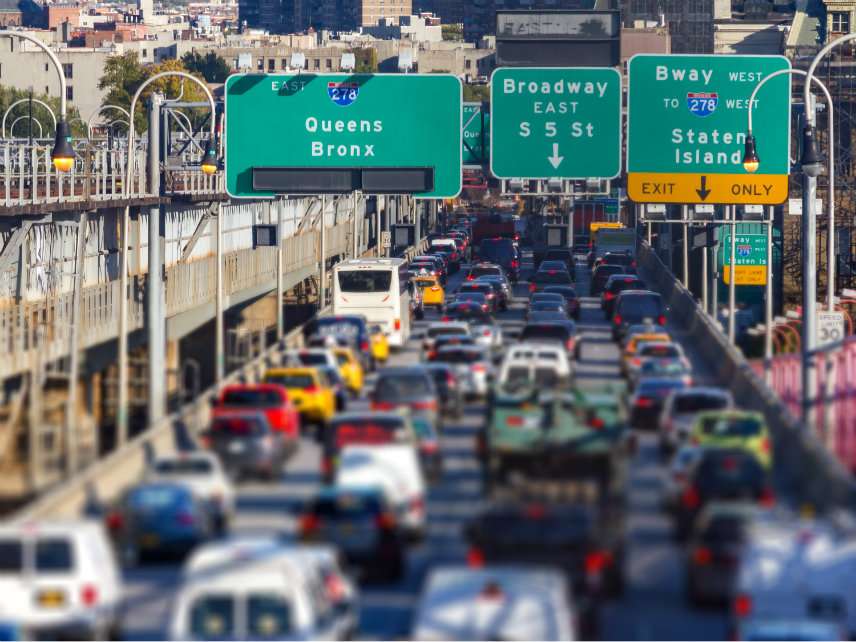American Commuters Lose 97 Hours, $87 Billion to Traffic Congestion, Says New Report
INRIX's 2018 Global Traffic Scorecard highlights the need for congestion pricing and new lanes to combat rush hour traffic.

The land of the free manages to have some pretty congested freeways. That's according to transportation analytics firm INRIX's new 2018 Global Traffic Scorecard, which ranks metro areas by how much time auto commuters waste in rush hour traffic.
Topping the list are European and Latin American metros, with drivers in Bogota, Moscow, and London all losing over 200 hours a year to congestion. U.S. cities look better by comparison, but commuters here still manage to idle away an incredible amount of time behind the wheel.
INRIX's scorecard finds Boston to be the most congested city in the country. Drivers there spend 164 hours (nearly a full week) in rush hour traffic each year. A close second is Washington, D.C., where commuters are losing 155 hours to gridlock.
Chicago, New York, Los Angeles, and Seattle fill out the rest of the top six in INRIX's rankings—which weigh time lost to congestion against a city's population—with drivers in these metros wasting between 128 and 138 hours a year in traffic. On average, commuters are losing 97 hours a year because of congestion.
INRIX develops these rankings by comparing travel times during peak hours to those during free flow conditions when there is no traffic. The difference between the two figures is the amount of time lost to traffic congestion.
Having congested roadways can be a huge drag on a city's productivity, according to the INRIX report.
"[Congestion] incurs costs from time loss, increased pollution rates, and higher incidents of accidents," reads the INRIX report, which estimates the cost of traffic congestion at $87 billion a year in lost time for drivers (roughly $1,365 for the average driver.) The freight industry loses another $74 billion a year to congestion.
In addition to the lost time is the lost opportunity that traffic congestion brings. The INRIX report cites research showing that whatever the levels of traffic congestion, people are generally only willing to spend one hour a day commuting—half an hour each way—with most people moving closer to work to cut down on travel times.
The more congestion limits where you can travel within that 30 minutes, as well as the employment and leisure opportunities you'll be able to comfortably access—limiting the advantages of living in an urban area in the first place.
Congestion, says Baruch Feigenbaum, a transportation analyst at the Reason Foundation (the nonprofit which publishes this website) is at its core a supply and demand problem. "Congestion is when you have more people than you have road space," Feigenbaum tells Reason, saying that the solution is a mix of adding congestion pricing to current road space and adding new lane miles.
The idea behind congestion pricing—variable tolls that rise and fall depending on the number of cars on the road—is that by charging drivers for the space they take up, they can be incentivized to take less congested routes or to travel in off-peak hours when traffic is lighter, improving road conditions for everyone.
A number of American cities are already giving this policy a hard look. In September 2018, Seattle Mayor Jenny Durkan included $1 million in her proposed budget to study congestion pricing. In December of that year, Oregon asked the federal government for permission to toll interstates around Portland (current federal law prohibits states from tolling most interstates). Last month, the head of Los Angeles' transit agency endorsed the idea as well; so too has New York Gov. Andrew Cuomo.
So far, Virginia is the only place in the U.S. to have implemented real congestion pricing, imposing variable tolls on parts of I-66 leading into D.C. The INRIX report notes that Singapore has managed to have both high levels of growth and low levels of congestion thanks to an aggressive policy of road pricing and high fees charged to vehicle owners.
Another option is to increase the supply of roads by adding new lane miles, which—when combined with some form of congestion pricing—can help to bring down traffic congestion, says Feigenbaum.
"Cities that have not been investing in their roadways at all, and not building any new lane capacity, are very high up on this list compared to their overall [population] size," Feigenbaum tells Reason. Road-adverse Seattle, he notes, is the 15th largest U.S. metro area by population, but manages to have the sixth-most congested roads, and travel speeds in the inner city nearly as low as New York City.
By contrast, Houston—the fifth largest metro in the U.S. and one that has continued to add more roadways to accommodate its growing population—ranks 13th on INRIX's scorecard.
Expanding roadways is not a cure all for congestion. More lanes can induce more driving, meaning more trips are taken but actual traffic flows stay about the same. Measures of roadway congestion can also understate urban mobility if a city has well-functioning transit options. INRIX's gives London as an example of a place where congestion has gotten much worse, but expanding transit options may well have increased overall urban mobility.
Feigenbaum says that transit can play a role in improving mobility in some American cities, provided it's the riders, not the taxpayers in general, that are paying for it. Improving congestion, however, he says, requires treating road space more like normal market goods, where prices rise and fall, and supply expands to meet demand.